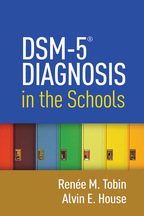DSM-5® Diagnosis in the Schools
Renée M. Tobin and Alvin E. House
I. Diagnostic Issues and the Use of DSM-5
2. Psychiatric Diagnosis: Issues for School Psychologists
3. An Overview of the DSM-5 Diagnostic System
4. Learning to Use DSM-5
II. Guidelines for Evaluation of Presenting Problems
5. Problems with Intellectual Ability and Cognition
6. Learning, Communication, and Motor Problems
7. Highly Atypical Symptom Patterns: Autism Spectrum Disorders and Psychoses
8. Mood Problems
9. Anxiety Problems
10. Other Internalizing Problems
11. Problems with Conduct
12. Problems with Impulse Control
13. Highly Focused Symptom Patterns
14. Substance-Related Problems and Other Addictive Behaviors
15. Personality Disorders
16. Additional Codes and Categories
III. The Application of DSM-5 In School Settings: Issues and Topics
17. Ethics and Professional Responsibility in Evaluation
18. The Case Record: Data and Supporting Documentation for Diagnosis
19. Seeking Reimbursement for Assessment and Diagnosis within School Settings
20. DSM-5 and the Individuals with Disabilities Education Improvement Act
21. Concerns about DSM-5



